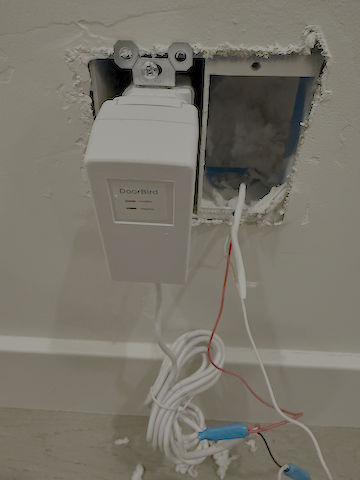I bought a house where there is a 'smart' doorbell installed, and it is powered from a DC wallwart that is plugged into the mains on the floor above. The mains receptacle for this power supply is in a split voltage box with high-voltage (HV) on one side and open-back LV on the other side. The LV line running back down to the doorbell was installed during construction and won't be easily moved, so the HV to LV interface has to happen in the location of this box. The previous homeowner had the wallwart plugged into the 120v receptacle and the output snaked back into the LV side - image below, minus the wall plate. Are there code compliant, or at least safe, in-wall/in-box power supplies that can tidy this up so it's all behind a wall plate? Legrand have a Wattstopper series of plenum-rated power packs, relays, controllers that mount through a knockout in a line voltage box. If I can find one of their devices that steps the voltage down sufficiently for the doorbell, is there any reason such a setup would not be code compliant? (Doorbell can take 8-24v DC or AC). Thanks in advance.
-
@crip659 That's 100% the answer. Just add "replace the plastic box with a metal box" and you're all set. Write it up and I'll +1– manassehkatz-Moving 2 CodidactCommented Dec 8 at 0:03
-
Are you trying to locate the outlet and wall wart inside a box?– HuesmannCommented Dec 8 at 17:11
-
No, not trying to put the wall wart inside the box. That's a code violation and unsafe: class 1 and class 1 limited-energy need to be separated by a physical barrier or insulated to the voltage of the higher class. And wallwarts are designed to be in open air for cooling. I'm looking for a plenum or in-wall rated power supply, preferably UL listed for that purpose, with a mounting solution that satisfies the code requirements (i.e. appropriate division/separation of different classes of wiring). Seems to be commonly asked question but I haven't found a good answer yet.– tangent360Commented Dec 8 at 23:25
1 Answer
If you replaced the plastic box with a metal box, this becomes easy.
Metal boxes have round cutouts on them, so a low voltage transformer can mount right on the side.
I do not know enough about plastic boxes, but you might find something to work, but means changing the box anyway.
Might be the reason they used the wall wart instead.
If you change the box, make sure the breaker is off first. Also test for no power/dead circuit before putting your fingers in the box. You test in case you turn off the wrong breaker or the breaker is labelled wrong or it is an older MWBC circuit without handle ties. Either one can make life too interesting.
-
Are you suggesting metal box because metal boxes have knockouts? or you think it also needs to be metal for some safety/code reason? I can drill a 'knockout' into the HV/LV divider of the box ... I have a very low profile right-angled drill attachment and bit for doing exactly this. And then if I could get the right device in a knockout mountable format it would be an ideal solution. But still have to find the right power supply. Thinking something like this or with that profile and mounting style. Commented Dec 8 at 3:22
-
@tangent360 Metal box is just easier. I do not know if it is in code to modify/drill a knockout hole in the plastic box, but if it is and you can do it, it should be good. If you have the proper tool it makes life easier, but most people would have to buy one. A search for door bell transformer will show a lot.– crip659Commented Dec 8 at 11:53
-
1@tangent360 metal boxes have knockouts. It IS for a safety/code reason, plastic boxes lose too much strength when you knock unintended holes in them. Also, most knockout-mount transformers depend on the metal box for grounding so now you'll need an RMC grounding bushing or something equally messy. Note AC transformer allowed, so any common $13 doorbell transformer is fine, you don't need an exotic power supply. Commented Dec 10 at 2:10

